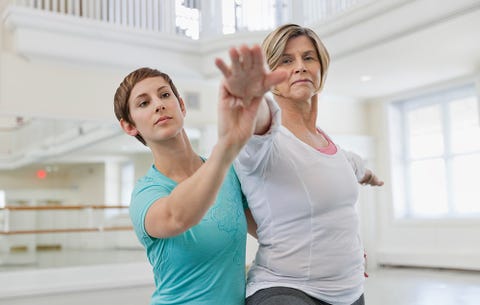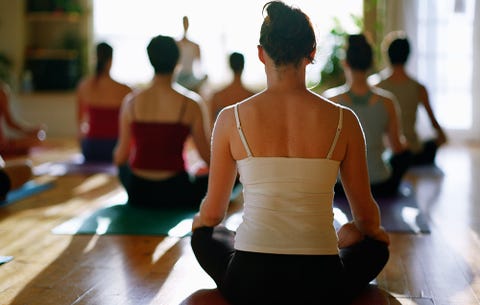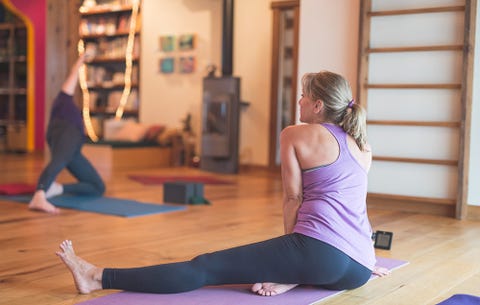How Much to Charge for Private Yoga Class
Yoga seems to be good for just about everything, from improved cardiovascular fitness, flexibility, and balance to reduced stress and anxiety. But as neighborhood yoga studios become as common as coffee shops and gyms add more high-octane classes with names like hard-core power yoga, some practitioners are discovering that there might be a downside to downward dog: Research published in theJournal of Bodywork and Movement found that although two-thirds of those studied found relief from preexisting pain by doing yoga, 1 in 3 experienced new or increased pain as a direct result of getting their ohm on.
"We tend to think of yoga as something gentle on our bodies, but it can actually cause pain and suffering if not done correctly, especially if the participant has physical limitations," says Barbara Bergin, MD, a board-certified orthopedic surgeon in Austin, Texas.
While some styles can be therapeutic, don't underestimate the power of the practice, says Linda Boryski, a licensed physical therapist from the University of Saskatchewan, who is also a medical yoga therapist. "Yoga can be very challenging physically, requiring substantial strength, flexibility, balance, and body awareness. People are often embarrassed to admit that they've been injured during yoga, I believe because of its reputation as a gentle form of exercise."
(You can sculpt your arms and tighten your tummy with the energizing—and fun—routines from Prevention's Flat Belly Barre!)
"Large classes make it challenging for teachers to correct [form] and watch for common errors that lead to injury," Boryski explains. "In many classes, teachers demonstrate a pose, usually at a very high level with excellent technique. Students are then driven to obtain that same level yet fail to understand how complex it is or how long the teacher has been practicing to get to that level."
Fast-paced classes leave little opportunity to learn things slowly; often, there just isn't time to show all the modifications available to make a pose safe for everybody in the room. Add in speed and repetition and it's no wonder some people end up getting hurt. "Yoga is a powerful practice for health improvement, but students can experience repetitive strain injury if they do not practice proper form," warns Atlanta-based yoga instructor Amber Barry.
MORE:12 Ways You Can Get More Out Of Your Yoga Class
Bergin also points out that as yoga has become more ubiquitous, it has also sometimes gotten more aggressive. "Instructors and gyms have been trying to appeal to younger generations by making yoga classes more about strengthening, sweating, and losing weight. Yoga, even in its most elemental practice, creates some liabilities for some people. But once it makes the leap to a calorie-spending, butt-burning exercise, it transcends itself into a completely different animal."
Despite the risks, instructors and health professionals say that by following some simple recommendations, most people can benefit from yoga and easily avoid injury. "Most of the injuries we see are in the shoulders, knees, and low back, and can be avoided with proper alignment of the feet, hips, spine and shoulders," says Barry. In addition to perfecting your pose (ask your instructor if you're unsure!), follow these tips to stay safe:
Do your research.

Hero Images/Getty Images
Find out the experience and education level of your teacher, and be sure to investigate a range of classes before making your choice. "I suggest that new practitioners start with a yoga basics workshop or one-on-one yoga session, rather than dropping into an 'all levels' group class," says Honolulu yoga instructor Valerie Brett Shaindlin. (Beware! These are the six times you should ignore your yoga instructor.)
Get moving at work with these stretches you can do in the office:
Follow your gut.

Hero Images/Getty Images
If you know that a body part is vulnerable (perhaps thanks to an old injury, arthritis, or surgery), then avoid doing exercises that intuitively seem like they might injure it, advises Bergin, who has treated patients for yoga-related meniscus and rotator cuff tears. "For example, if you've had a rotator cuff problem, don't do downward dog or any push-up type exercise."
MORE:These 6 Simple Yoga Poses Can Help Ease Your Sciatica Pain
Keep it cozy.

Andrea Wyner/Getty Images
Look for small classes, ideally an 8:1 student to teacher ratio," says Boryski. Adds Bergin: Try to avoid participation in large, competitive exercise-type classes, especially if they're playing loud, fast music, and you're over 40. "Many injuries occur in these types of classes." (Make sure you're prepared for class with these five pairs of underwear that won't show through yoga pants.)
Express yourself.

Chombosan/Getty Images
Never be afraid to speak out if something hurts, and don't "work through" anything greater than a little muscle soreness, says Bergin. "Listen to your body. Don't think that pain is noble and something you need to tolerate in order to get better."
PREVENTION PREMIUM:6 Best Yoga Poses To Soothe Menopause Symptoms
Respect your limits.

FatCamera/Getty Images
Resist the urge to try and "keep up" with other students and the teacher, which can lead to pain and injury, says Deborah Quilter, a yoga therapist and the founder of the Balance Project at the Martha Stewart Center for Living at Mount Sinai Hospital in New York. "Students need permission to stop when they've had enough and to modify or skip poses that are inappropriate for them. The results of ignoring these safeguards can result in serious injury." (These are the 25 thoughts everybody has in their first yoga class.)
Go at your own pace.

Oktay Ortakcioglu/Getty Images
Remember: It's always okay to take your time. "Master a pose or sequence of poses at a slow pace before adding speed and repetition to your practice," stresses Boryski. (Find out what happened when one of our editors did yoga every morning for two weeks.)
The bottom line, experts say, is that yoga shouldn't hurt. Find a teacher you feel comfortable with and don't push yourself before your body is ready. "Yoga is incredibly vast, but postures don't need to be advanced or difficult," says Brianna Bedigian, a Davidson, North Carolina yoga instructor, intuitive healer, and author of the bookHealing: Footstep to Footstep. "In many cases, the simpler they are the better they are for you."
This content is created and maintained by a third party, and imported onto this page to help users provide their email addresses. You may be able to find more information about this and similar content at piano.io
How Much to Charge for Private Yoga Class
Source: https://www.prevention.com/fitness/a20489060/avoid-yoga-injuries/
0 Response to "How Much to Charge for Private Yoga Class"
Post a Comment